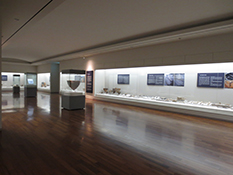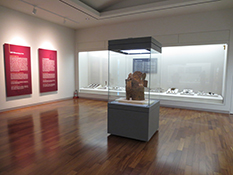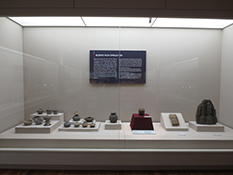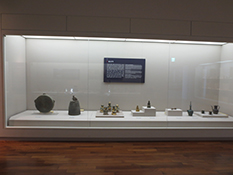

The oldest trace of humans in Busan can be found in relics of Jwa-dong and Jung-dong, Haeundae-gu.A variety of chipped stone implements were excavated from the relics, including stone axes, choppers, sealed wax, a rocking tool, and a stone blade estimated to be 15,000 to 20,000 old, which suggests that people have lived in Busan since the late Paleolithic Age.
Roughly 7 to 8,000 years ago, Neolithic people lived together by the sea, which offers rich food resources, and left housing sites, graves, and shellfish graves. Also displayed is herringbone earthenware excavated from the Beombang ruins in Gangseo-gu and Dongsam-dong shell mounds in Yeongdo-gu, including grinded stone axes, fishing hooks, shellfish bracelets, and stone earrings that show the tool development at the time. Visitors can also examine the eating habits then through the bones of a variety of fish, roe deer, and wild boars excavated from the shell mounds. The museum features data from the Janghang ruins of Gadeokdo Island that exposes the burial culture of the Neolithic Age, including obsidian and Jomong potteries, which show the interchange with Japan across the sea.
Three-thousand years ago, the people of the Bronze Age in Busan lived on low hills or around rivers and lived agricultural lives. The dwelling sites in Oncheon-dong, Dongnae-gu and Nohpo-dong, Geumjeong-gu and the burnished red pottery, stone knives, stone arrowheads, crescent-shaped stone knives, and stone chisel excavated from the dolmen tombs in Mieum-dong, Gangseo-gu and Sajik-dong, Yeonje-gu demonstrate the full-scale of the Bronze Age, such as the agrarian life and occurrence of classes.
With the introduction of iron culture in the late Bronze Age, Dokro Country, one of the 12 countries of Byonhan was created in Busan. New earthenware, such as gray-toned quality earthenware tiles and wooden-walled tombs appeared and were used widely, including various tools and weapons, such as iron swords, iron arrowheads, axes, and weed plows.

With widespread use of ironware and in the wake of the turbulent period where wars were frequent, the three small countries of Korea developed to an ancient nation through integration with small countries. The growth of Dokro Country in Busan initiated through a special relationship with Geumgwan Country of Gimhae in the 4th century. However, Silla established its culture when it entered here after the 5th century. Bokcheon-dong Tombs in Dongnae-gu and tombs examined in Yeonsan-dong Burial Mounds in Yeonje-gu and various remains, such as gold-bronze crowns, horse equipment, armors, and bowl stands display the image of Busan's cultural transition period.
Silla, which unified the Three Kingdoms, reshuffled local systems in 685 (the 5th year of the King Sinmun's reign) to establish centralized governance and implement Gunhyonjae system, which dispatched central managers to local countries and townships. Busan was organized as Dongnae-gun of Yangjoo in (Today's Yangsan) in 757 (the 16th year of the King Gyeongdeok's reign), and began using the Chinese character name Dongnae. Buddhist culture was widespread during the period, and cremation, a Buddhist funerary practice, was prevalent nationwide. Large and small temples were constructed nationwide, which led to the building of Beomeosa Temple and the Jangansa Temple, one of Hwaeomsipchal temples in the Busan region.
After the unification of the later Three Kingdoms, Goryeo reorganized local government districts, whichlowered the standing of the Busan region; Dongnae-gun was organized as an affiliated region of Uljoo (Ulsan), which was the main township where local magistrates had been dispatched since the period of unified Silla and Gijanghyeon. Dongpyeonghyeon, which used to be an affiliated township of Dongnae-gun had become an affiliated township of Yangjugun (Yangsan). Busan during the period can be seen through Nokcheongja excavated from the major Caledon point in Noksan-dong, quality Caledon excavated from grave monuments in Deokcheon-dong, Buk-gu, and through tiles excavated from the Nakmin-dong ruins and the ancient town palace in Dongnae.

Silla that had unified the Three Kingdoms began to execute the Ju Gun and Hyeon System by reorganizing the local government system in 685(5th year of King Sinmun) for the purpose of centralized authoritarian ruling. As the local government system has been organized, the social atmosphere got to be different from the time before the unification.
Busan, which was in the outskirts of the unified Silla was incorporated into Dongnae-gun, a part of Yangju, and named Dongnae in 751(16th year of King Gyeongdeok), which is derived from Chinese characters. In connection with Busan, some records and stories came to us, including a record that the Silla kings visited Dongrae hot spring several times and a story that Choe Chi-Won came to Haeundae to rest there, who was frustrated when his suggestion to reform the political system was rejected by Qeen Jinseong. During this time, as Buddhism spread, Beomeosa (temple) was built in Busan, too, where are still the 3 Story Stone Tower and Stone Lamp, etc. Beomeosa, one of the 10 Hwaeom-sect temples, is said to be initially built in mount Geumjeong in 678(18th year of King Munmu) and rebuilt in 830(10th year of King Heungdeok). Around this time, the first roof-tiled building was built, too. The relics of Unified Silla that remain in Busan include many items related to daily life such as earthenware kiln, etc.

After the unification of Later Samguk(Three Kingdoms) by Goryeo(918~1392), Busan became a remote place far from the center of politics. As a result, when compared even with the neighboring area like Ulsan, Yangsan, etc., Busan became politically neglected in the early Goryeo era. The Dongrae-gun, which was a Ju Hyeon where was a local officer dispatched from the central government even in the Unified Silla, lost its status early in Goryeo, being incorporated into Ulju(Ulsan) in 1018(9th of King Hyeonjong), and the Gijang and Dongpyeong hyeon that belonged to Dongrae-gun was incorporated into Ulju and Yangju(Yangsan) respectively.
But after the middle years of Goryeo, especially under King Uijong's reign, Busan produced many relatively important persons such as Jeong Seo who composed Jeong Gwajeong-gok, the Song of Jeong Gwajeong', gradually becoming an important area in politics. Also according to its geographical condition, its approximation to coastal areas and a large river, the importance of Busan gradually emerged struggling through the periods of Mongol resistance, Sambyeocho(three units of remnant resistant Korean soldiers) resistance, and the Japanese invaders domination on the southern and western coasts. Thereafter in Joseon Dynasty, it emerged to the front of history as a gate for entering into friendly relations with Japan.